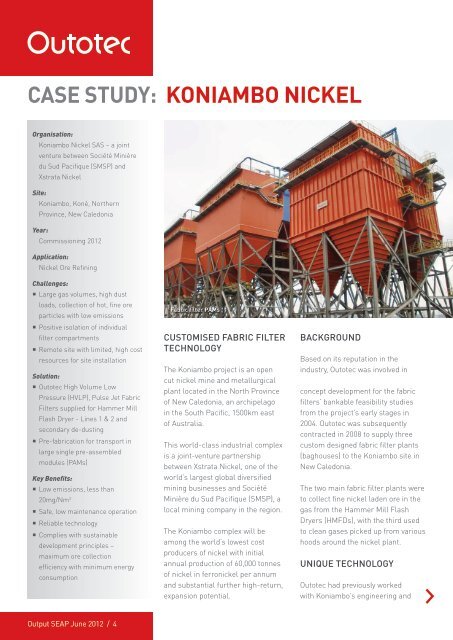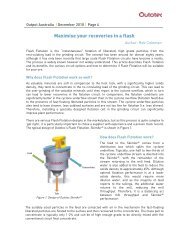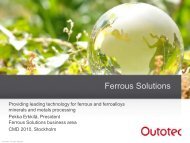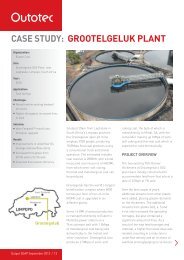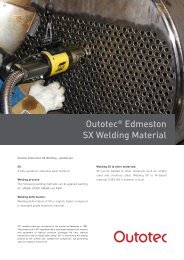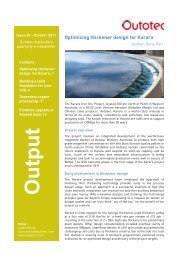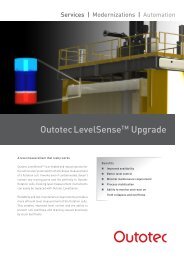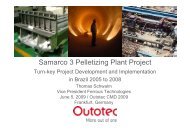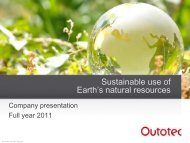You also want an ePaper? Increase the reach of your titles
YUMPU automatically turns print PDFs into web optimized ePapers that Google loves.
<strong>case</strong> <strong>study</strong>: KONIAMBO NICKEL<br />
Organisation:<br />
Koniambo Nickel SAS – a joint<br />
venture between Société Minière<br />
du Sud Pacifique (SMSP) and<br />
Xstrata Nickel<br />
Site:<br />
Koniambo, Koné, Northern<br />
Province, New Caledonia<br />
Year:<br />
Commissioning 2012<br />
Application:<br />
Nickel Ore Refining<br />
Challenges:<br />
• Large gas volumes, high dust<br />
loads, collection of hot, fine ore<br />
particles with low emissions<br />
• Positive isolation of individual<br />
filter compartments<br />
• Remote site with limited, high cost<br />
resources for site installation<br />
Solution:<br />
• <strong>Outotec</strong> High Volume Low<br />
Pressure (HVLP), Pulse Jet Fabric<br />
Filters supplied for Hammer Mill<br />
Flash Dryer - Lines 1 & 2 and<br />
secondary de-dusting<br />
• Pre-fabrication for transport in<br />
large single pre-assembled<br />
modules (PAMs)<br />
Key Benefits:<br />
• Low emissions, less than<br />
20mg/Nm 3<br />
• Safe, low maintenance operation<br />
• Reliable technology<br />
• Complies with sustainable<br />
development principles –<br />
maximum ore collection<br />
efficiency with minimum energy<br />
consumption<br />
Fabric filter PAMs<br />
Customised fabric filter<br />
technology<br />
The Koniambo project is an open<br />
cut nickel mine and metallurgical<br />
plant located in the North Province<br />
of New Caledonia, an archipelago<br />
in the South Pacific, 1500km east<br />
of Australia.<br />
This world-class industrial complex<br />
is a joint-venture partnership<br />
between Xstrata Nickel, one of the<br />
world’s largest global diversified<br />
mining businesses and Société<br />
Minière du Sud Pacifique (SMSP), a<br />
local mining company in the region.<br />
The Koniambo complex will be<br />
among the world’s lowest cost<br />
producers of nickel with initial<br />
annual production of 60,000 tonnes<br />
of nickel in ferronickel per annum<br />
and substantial further high-return,<br />
expansion potential.<br />
Background<br />
Based on its reputation in the<br />
industry, <strong>Outotec</strong> was involved in<br />
concept development for the fabric<br />
filters’ bankable feasibility studies<br />
from the project’s early stages in<br />
2004. <strong>Outotec</strong> was subsequently<br />
contracted in 2008 to supply three<br />
custom designed fabric filter plants<br />
(baghouses) to the Koniambo site in<br />
New Caledonia.<br />
The two main fabric filter plants were<br />
to collect fine nickel laden ore in the<br />
gas from the Hammer Mill Flash<br />
Dryers (HMFDs), with the third used<br />
to clean gases picked up from various<br />
hoods around the nickel plant.<br />
Unique Technology<br />
<strong>Outotec</strong> had previously worked<br />
with Koniambo’s engineering and<br />
Output SEAP June 2012 / 4
Assembly of the fabric filter PAMs<br />
Moving the PAM via self-propelled modular transporter<br />
procurement contractors in supplying<br />
High Volume Low Pressure (HVLP)<br />
pulse jet filter technology, so<br />
partnership was easily established.<br />
Additionally, <strong>Outotec</strong>’s long track<br />
record using HVLP technology<br />
in process industry and utility<br />
applications is well known. The<br />
HVLP technology is unique when<br />
compared to conventional technology,<br />
as its design uses low pressure<br />
pulses and a rotating cleaning<br />
system. This design results in high<br />
reliability, long bag life and low<br />
maintenance.<br />
Extensive Modelling<br />
Extensive flow modelling was<br />
conducted to ascertain the optimum<br />
flow distribution using both physical<br />
modelling and Computer Fluid<br />
Dynamics (CFD). Once the overall<br />
design was finalised, a 1:10 scale<br />
model was built, with further testing<br />
carried out on gas distribution<br />
screens and baffles to ascertain<br />
optimum gas flow distribution.<br />
Additional CFD modelling was also<br />
used to confirm findings from the<br />
physical modelling. Testing of the<br />
scale model was verified by the<br />
University of NSW – Research<br />
Testing Facilities.<br />
The solution and testwork were<br />
challenging as changes were<br />
necessary to the conventional<br />
baghouse layout to incorporate<br />
positive isolation guillotine dampers<br />
into each compartment. However<br />
the resulting <strong>Outotec</strong> design was<br />
engineered to overcome these<br />
challenging criteria, without altering<br />
the fabric filter plant’s footprint or<br />
compromising gas distribution.<br />
PAM Feasibility <strong>study</strong><br />
Delivery of the PAMs presented<br />
a new and interesting challenge<br />
with the initial concept based on<br />
splitting the baghouse components<br />
into a number of large modules<br />
for shipment and erection at site.<br />
However, further discussions were<br />
held regarding even larger modules,<br />
leading to <strong>Outotec</strong> assessing the<br />
potential for each baghouse to be<br />
delivered as one large single module.<br />
This large scale modular construction<br />
would require careful planning,<br />
delivery coordination and detailed<br />
route assessment, utilising <strong>Outotec</strong>’s<br />
previous experience in the delivery<br />
of PAMs to remote sites, including<br />
calciners to Gove in Northern<br />
Australia.<br />
After considering issues such as the<br />
distance, the assembly configuration,<br />
local labour and infrastructure, the<br />
outcome of the <strong>study</strong> indicated that<br />
a full PAM delivery was feasible and<br />
the preferred method for the project.<br />
<strong>Outotec</strong>’s original contract scope was<br />
subsequently altered to include full<br />
PAM delivery of the fabric filters.<br />
Delivering the PAMs<br />
The baghouses were constructed<br />
on temporary foundations overseas,<br />
with all steelwork, insulation,<br />
cladding, access and stairways<br />
installed. Mechanical equipment<br />
and piping were fitted and precommissioned<br />
where possible.<br />
This equipment included pulse<br />
cleaning systems, complete with<br />
pressure vessels, cell ventilation<br />
hatches and pulse air piping.<br />
With construction complete, each<br />
pre-assembled baghouse was loaded<br />
Output SEAP June 2012 / 5
onto the ship using a number of<br />
Self-Propelled Modular Transporters<br />
(SPMTs). The SPMTs have a grid of<br />
several dozen computer controlled<br />
wheels, all individually controllable<br />
and steerable. Each wheel can swivel<br />
independently from the others,<br />
allowing the SPMTs to turn, move<br />
sideways, or even spin in place.<br />
The SPMTs lifted the baghouses via<br />
transport beams attached low on the<br />
support structures. Once loaded onto<br />
the ship, the beams were welded to<br />
the deck, with shipping completed<br />
over a 4-6 week period. Upon arrival<br />
in New Caledonia, SPMTs were once<br />
again used to transport the fabric<br />
filter plants and lower them into<br />
position on the foundations at the<br />
nickel plant site.<br />
The two HMFD baghouses weighed<br />
1,158 tonne each, including transport<br />
steel, with the secondary filter plant<br />
PAM weighing 489 tonne including<br />
transport steel, giving a total of 2,805<br />
tonne. The transport steel comprised<br />
of temporary beams and bracing<br />
added to the baghouse structures to<br />
accommodate the additional loads<br />
during shipment to site. The transport<br />
beams were sized to support the full<br />
dead load of the baghouses and the<br />
transport bracing was required to<br />
resist forces produced by the pitch<br />
and roll accelerations of the ship<br />
while at sea. The transport steel<br />
was removed once the PAMs were<br />
positioned on their foundations.<br />
Challenges<br />
The location of a large nickel<br />
processing plant on a remote<br />
Pacific island presented difficulties<br />
in resourcing qualified expertise in<br />
construction. The decision to build<br />
the majority of the plant overseas<br />
was initiated by this factor.<br />
With regards to the fabric filter plant,<br />
once its construction was complete,<br />
transportation to site was the next<br />
challenge, demanding additional<br />
engineering input, multi-lingual<br />
co-ordination and planning. For<br />
example, <strong>Outotec</strong> produced various<br />
engineering documents and drawings<br />
in three separate languages. Final<br />
installation of the plant at New<br />
Caledonia required internationally<br />
sourced supervisors and tradesmen<br />
to be flown in.<br />
Unique process =<br />
unique technology<br />
The nickel refining process at<br />
Koniambo is unique, with the ore<br />
milling and drying completed in one<br />
process (the Hammer Mill Flash<br />
Dryer) and the baghouse integrated<br />
into the main process flow sheet.<br />
<strong>Outotec</strong>’s baghouse technology is<br />
therefore not solely considered as<br />
pollution control equipment but<br />
also as solids separation devices,<br />
critical in ensuring reliable delivery<br />
of feed solids to all downstream<br />
equipment.<br />
Each baghouse must be operational<br />
in order for its process plant to<br />
work, so high availability and<br />
reliability are essential. Both<br />
baghouses handle flash dryer offgas<br />
when the dryer is operating and<br />
calciner off-gas when the flash dryer<br />
is not operating.<br />
High dust load and fine particle<br />
sizing, combined with a high<br />
collection efficiency and low<br />
emission requirement, demanded<br />
careful selection of the bag filter<br />
material along with careful design<br />
Delivery of the PAMs to Koniambo<br />
Output SEAP June 2012 / 6
of the gas flow path to each<br />
filter compartment. In addition,<br />
excellent quality control in both<br />
bag manufacturing and installation<br />
procedures were required for low<br />
emissions to be achievable.<br />
The final design incorporates positive<br />
isolating guillotine dampers for<br />
safe personnel access. However, as<br />
previously mentioned, this design<br />
was achieved without compromising<br />
filter performance whilst still<br />
fitting within the original footprint<br />
constraints.<br />
The result<br />
<strong>Outotec</strong> delivered the fabric filter<br />
technology on time and, thanks to<br />
highly detailed planning, engineering<br />
and close co-operation with all<br />
parties, the baghouses were<br />
installed without any difficulties.<br />
With particulate emissions of less<br />
than 20 mg/Nm 3 , the baghouses<br />
will minimise any harm to the local<br />
environment as well as maximise<br />
the ore feed to the process, with a<br />
minimum energy consumption.<br />
Quick tip<br />
Gas dispersion in your flotation cell<br />
The gas phase of any flotation cell is critical for optimum<br />
cell performance. Understanding and varying these four key<br />
parameters can improve recovery. At one site, for example,<br />
up to 30% was achieved at the same grade:<br />
• Gas hold-up<br />
• Bubble size and bubble size distribution<br />
• Superficial gas velocity<br />
• Bubble surface area flux<br />
Once you have the right tools and expertise to benchmark the<br />
gas dispersion in your current flotation cells, it becomes far<br />
easier to get the most out of your operation...<br />
Australia Coal Preparation Society<br />
Meet <strong>Outotec</strong> at Booth 17, Hotel Realm, Canberra<br />
September 9th-13th, 2012<br />
This project reinforced <strong>Outotec</strong>’s<br />
continued development in executing<br />
these types of large scale installations<br />
using very large PAMs.<br />
Commissioning of the baghouses and<br />
associated infrastructure is due to<br />
take place in 2012.<br />
If you would like more<br />
information click here<br />
to contact<br />
rod.bale@outotec.com<br />
Quick tip<br />
Thickener tank design options<br />
Reviewing and questioning the way we ‘normally’ do things<br />
can result in simple, clever and more cost-effective options.<br />
Reviewing thickener tank design, for example, can bring<br />
substantial rewards. So what are your options<br />
• Piece small fabrication<br />
• Piece large fabrication<br />
• Fully pre-assembled<br />
• Bolt together<br />
When analysing the above options you not only have to look at a<br />
thickener’s capital cost, but also take installation time, risk and<br />
final quality or workmanship into consideration...<br />
Output SEAP June 2012 / 7


